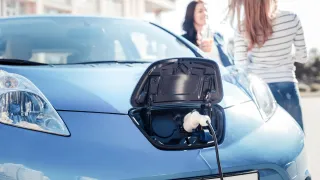Why it is not possible to charge an electric car at home or at a housing company as fast as filling up a car with a combustion engine? Why should housing companies invest in electric car charging when all other cars must be filled up separately at petrol stations? When and how should an electric car be charged? Does charging affect the power grid?
As the number of electric cars increases, charging them has provoked discussions both in the media as well as among ordinary consumers. Charging electric cars at housing companies was discussed recently in the Finnish ‘Huomenta Suomi’ breakfast television show. At the end of a good introduction to the subject, the television presenter asked why could we not charge electric cars in just 15 seconds at housing companies too, just as electric buses are charged with the technology launched by ABB, for example? I came up against the same issue while connecting my own electric car to a public charging station, when a passer-by asked me why charging an electric car takes so long, and why not just figure out a way to charge an electric car “in a jiffy”?
Battery technology limits the charging capacity
The battery technology currently used in electric cars still limits the maximum battery charging capacity. Promising technologies are currently under research, and car manufacturers seem to be investing especially in solid-state batteries that make it possible to increase the charging capacity. However, most car manufacturers are not planning to start manufacturing such batteries commercially until some time between 2025 and 2030.
Most of the electric cars currently on the market are equipped with rapid charging that allows a maximum charging power of 50 kW, and the next step will be to increase the capacity to 100 kW within the next few years. Porsche is taking the lead with its Taycan model to be released in 2019 with a charging capacity of 350 kW, but charging the Taycan requires special high power charging stations that Fortum and the K Group are planning to build in Southern Finland as a first step.
The rapid charging of current electric cars at their maximum charging power takes 30 to 40 minutes. Even though the maximum charging power for cars will increase up to 100 kW on average in the next few years, it will still not make rapid charging any faster, because the battery sizes are growing at the same time. This means that the rapid charging of ordinary electric cars will take roughly half an hour in the near future, too.
Electric cars should be charged when they are parked
Very few private individuals drive their cars around the clock. Usually the car is parked during the night, and many cars also spend their office hours in the parking lots of workplaces. These are the best times and places to charge electric cars. Charging both at home and at the workplace makes using the car easier compared to a car with a combustion engine, because it will only need to be “filled up” separately during long journeys. Charging at commercial charging points, for example while doing shopping, supports nicely charging at home and at work. Connecting the car to a charging station takes less than a minute, which means that the long charging time of an electric car does not disrupt its use in normal everyday driving.
Costs increase with the higher charging power
The currently popular 50 kW rapid chargers cost approximately €50,000, including installation. Total costs of higher power rapid chargers will not be proportional to the power, but the costs will be higher, because in addition to a higher capacity power supply, the increased charging capacity will require liquid cooling for the charging cables, a more robust grid connection, and more cooling due to increased power losses. Electricity companies are starting to use power tariffs, which means that also the usage of a rapid charger will become more expensive. The more powerful the charger used, the higher will be the cost of the charger, electrical connection and the power fees per kilowatt-hour charged.
For example, a housing company that owns an indoor car park could equip 20 to 50 parking spaces with chargers operating at a normal charging power for the price of one 50 kW rapid charger.
Effect of electric cars on the power grid
In future, electric cars can also support the power grid, offering flexibility during consumption peaks and also enabling the maximal use of renewable energy sources. If electric cars can be included in the charging network as managed resources during both nights and working days, the full benefit of electric cars for the power grid can be achieved even without V2G (Vehicle-to-Grid) support. Among other things, the Smart Otaniemi project includes a pilot study investigating this. If electric cars were charged with rapid charging only, the effect would be reverse – power peaks in the power grid would increase, making the load much more uneven and difficult to predict. Wide use of high charging power would require reinforcing the power grid, while it could be utilized to a very large extent as it is at more moderate charging powers.
Slow is better than superfast when charging at home
Overall, the most economical option for society, the consumers and the housing companies is to charge electric cars regularly at normal speed at home and/or at the workplace with smart charging management.
The driving needs of an average Finn can be fulfilled with a surprisingly low charging power. For example, charging overnight with a current of 8 amperes (comparable to the power consumption of an ordinary electric oven) gives the car battery enough energy to drive 100 km, which is enough for the daily driving needs of many drivers and may even leave spare charge in the battery.
However, housing companies should prepare for a portion of the residents needing more charging capacity than average, and the needs of a single user may also vary over time. This means that the charging system should not be sized too small; instead, the system should be flexible enough for different kinds of needs and an increasing demand over time.
Rapid charging is definitely needed for covering longer distances, which is why it is good that both the rapid charging network and the rapid charging capacity of the cars are developing at a fast rate. However, it is still better to charge electric cars at home and the workplace slowly, not superfast.
Read and see more about the subject:
Fortum
Kesko
Liikennevirta




